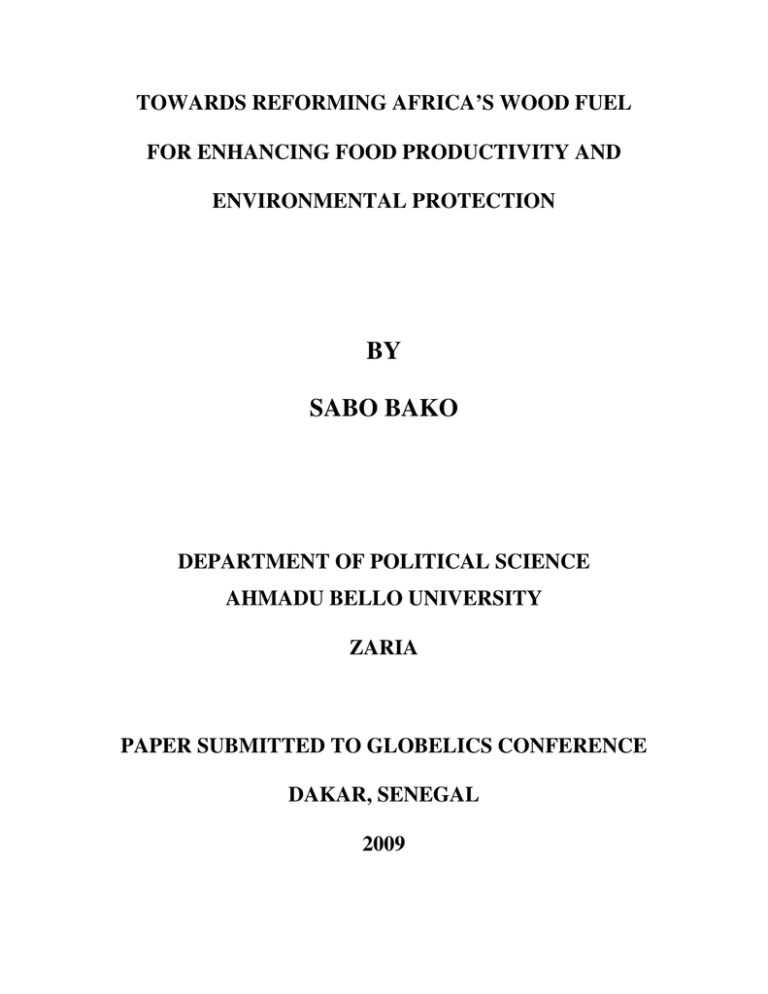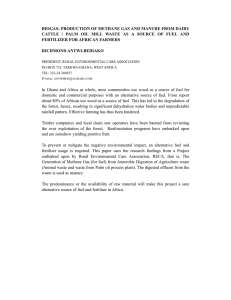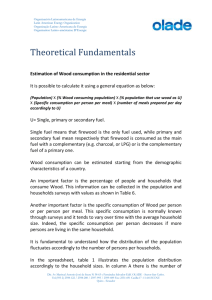BY SABO BAKO
advertisement

TOWARDS REFORMING AFRICA’S WOOD FUEL FOR ENHANCING FOOD PRODUCTIVITY AND ENVIRONMENTAL PROTECTION BY SABO BAKO DEPARTMENT OF POLITICAL SCIENCE AHMADU BELLO UNIVERSITY ZARIA PAPER SUBMITTED TO GLOBELICS CONFERENCE DAKAR, SENEGAL 2009 ABSTRACT This paper explains the growing relationship between the crises in Africa’s most widely used energy of wood fuel and food production in the continent. It argues that the optimal productivity of agricultural land has been on a steady decline due to the massive disappearance of soil nutrients occasioned by systematic tree cutting, constituting one of the central factors responsible for lowering food production in Africa. Wood fuel is the biggest source of energy for the overwhelming African households, in which over ninety percent of the continent’s populations depend on for cooking, heating and other domestic energy generating activities. It is, at the same time, the fastest diminishing energy due partly to its wasteful mode of utilization and partly to the growing gap between its consumption and production. The food crisis, manifests itself at the growing Africa’s food deficits and imports, shortages and soaring prices, and the increasing number of Africa’s population afflicted by hunger, malnutrition and mortalities. Using gap theory, data accumulated from wood fuel consumption and food production for the past forty years have been correlated in order to establish the growing pattern of their linkages and intersection. The result of the study shows that wood fuel and food crises are not only interconnected, but they also reinforce each other in their growing manifestation and gravity. The current Africa’s food deficit could be attributed to up to 70% to the negative effects of wood fuel utilization and depletion. In fact, by the current rates of wood fuel consumption, population explosion and food decline, food deficit in Africa is expected to double in the next decade. This ugly situation can be prevented on the short term by reducing the wood fuel wastage and utilization of non tree or dead biomass, through an effective but multiple purpose stoves, which could save about 90 percent of the inefficiently utilized trees and increase food production by the same percentage in the continent. The long term solution to wood fuel and food crises could be sought in what I propose as a complete shift from wood fuel to much more easily renewable and sustainable solar and wind energy, in order to provide sufficient food for all and protect the biodiversity of the African environment. 1 INTRODUCTION This paper explores the growing linkage emerging between energy consumption and food production in Africa. It specifically studies how energy crisis brewing in the wood fuel sector affects the decline and crisis in food production in the continent. To study the nature and pattern of the relationship right from their co-existence, development, and to possible remedies, the paper presents its discussion as follows: First, it provides definition of the nature and dimension of what it conceptualizes as energy and food crises within the framework of gap theory. The second section illustrates the growing linkage between energy and food crises during the past four decades. The third part recommends some remedies on how to tackle them from both the short term and long term perspectives in Africa 2 1. TOWARDS THEORIZING ENERGY AND FOOD CRISES IN AFRICA It is now becoming very apparent that energy and food crises have emerged to be part of Africa’s biggest problem that increasingly threatens the survival of the continent. These crises and their spillover effects, if not carefully studied and tackled, could bring about the biggest doom to human development in Africa. It is imperative, therefore, to identify and explain their common denominators and roots particularly in their growing linkages and resolution. The fact that Africa faces huge energy crisis virtually in all sectors and sources is no longer news. The crisis manifests itself glaring in the modern sector as can be seen in the current acute shortage of electricity and fossil fuels, which actually arrest the continent’s modern, social and economic development. Another crisis exists also in the traditional energy sector of wood fuel, which supply virtually all the energy required necessary needed for household cooking and heating there. However, the crisis in the traditional sector appears to be much more devastating than that of the modern sector, not all because if deals with the cooking of food for well over ninety seven percentage of the African population, but also because its role of energy utilization and procurement directly and instantly 3 the affect the fertility of African soils, agriculture as well as ecosystem which produce and support human lives with the quantity and quality of food for sustenance and raw materials for Agro-allied industrialization here. The tragedy of the wood fuel procurement is that it relies almost absolutely on cutting trees, which invariably becomes a serious societal dilemma over its continuous utilization on a sustainable basis. Thus even though tress are renewable resources, it takes quite some time to renew them, and their rate of consumption far exceeds the overall rate renewal. As tree crop replenishment is much slower that its consumption, the aggregate numbers of trees bound to diminish until the last one is burned for cooking fuel. Wood fuel , therefore, is the major cause of soil erosion, desertification and deforestation in Africa. Wood fuel consumption is not only linked to tree depletion, but to also land and agricultural degradation, which is central source of the decline of food production in Africa. In the connection, energy crises in wood fuel consumption and the one in food production could be explained and measured by employing an extended version of the gap theory at its four levels of analysis and interconnectedness in the continent. These four levels are as follow: (i) Utilization Gap: This relates to the wasteful mode of utilization in which a big gap exists between effective and ineffective wood fuel utilization. This 4 gap involves currently an estimated wastage of tree and loss of food within the region between 40% to 94% in Africa (Openshaw 1980 and Mu’azu 1988) (ii) Consumption and production Gap: This is the main cornerstone of the gap theory, which asserts its existence between total wood fuel consumption and its production. Accordingly, wood fuel utilization far lags behind its production virtually in all the climatic regions of Africa. (The FAO wood fuel data 1960 to 1990s; RWEPP 1997a, 20, Mathews, 2000) (iii) Optimal and Marginal Soil fertility gap. This gap relates to the gap in soil fertility as provided by the quantity and quality of food produced depending on the level and amount of nutrients, water and other minerals contained in the soil. (Conner, 2006) (iv) Marginal Soil productivity and population growth gap. As the soil continues to produce less food, this is accompanied by increasing number of more mouths to feed, arising from the rapid annual population growth which all African countries experience. The gap, therefore, exists and widens between the decline of food production and an upsurge in population, requiring more food for their sustenance. 5 These four levels of the gap theory must be brought to bear on the trend of the crises manifesting in the energy sector and food production particularly during the past four decades in African. 6 2. THE TREND IN ENERGY AND FOOD CRISES IN AFRICA It is very important to put the African energy and food crises on the proper historical perspective. There was nothing like the woof fuel and food crises in the 1960s and early 70s. The continent was not only producing its sufficient food and raw materials, but also exporting a large quantity overseas. Agricultural raw materials constituted their major source of foreign exchange earnings. The energy crisis in the Wood fuel sector arising from the decline of land productivity as a result of cutting trees for wood fuel consumption was during this period largely invisible. The energy crisis began to show itself from the late 70s, when wood fuel consumption started to increase astronomically against its production particularly in third world countries. According to FAO third word countries are the world biggest producers and consumers of wood fuel. Wood fuel energy contributes only 3 percent of total energy supply in the developed countries. Biogas produces roughly 30 percent of the total energy supply in the developing countries. But in sub-Saharan Africa, wood fuel provides over 80 percent of the total energy requirement. Thus, Africa and Asia alone use 75% of global wood fuels and also produce the same as shown in Fig 1 below: 7 Asia and Africa use 75% of global Wood fuels Fig 1. Global wood fuel production, 1998 Central America &Caribean 3% Eastern Europe 1% South America 10% Western Europe 2% FormerUSSR 3% Asia 50% Africa 27% North America 4% Source: FAOSTAT Note: Wood fuels production in 1998 totaled 1.8 billion cubic metres It is important to note that five countries of the world – Brazil, China, India, Indonesia, and Nigeria – account for about half of the world firewood and charcoal produced and consumed each year (Mathers, 2000). It was estimated that of the 4.4 billion cubic meters (m3) of global wood harvested in 1996 , close to half – some 1.9 billion (m3) were burned for cooking and provision of heat (FAO, 1999:144). Nigeria is said to use about 100 million cubic meter of fire wood consuming some 40,000 hectares of tree plantation 8 annually. (Mu’azu, 1998). The wood fuel share according to the world regional distribution, production and consumption is indicated in figure 2 below: Wood fuels consumption begun to experience a crisis at the same time as the crisis of food production, which both commenced from the late 70s in sub-Saharan Africa. The correlation in the trend of their growth could be explained by employed the gap theory as proposed above. 9 The first source of wood fuel crisis could be attributed its wasteful mode of utilization on open-air pot arranged fire in Africa., African fuel consumption and production was by 1975 about 400 cubic metres which rises to about 800 cubic metres by 2009. It is estimated that over 90% of the amount of wood fuel utilized annually could be saved by employing an effective and multipurpose stove . (Mu’azu, 1988. 1998, Adegvoke, 1995, and Quatura 1989). This means that if proper and efficient utilization of wood fuel was employed. the African consumption and production could not be more than 40 cubic metres and 80 cubic metres in 1975 and 2009 respectively. This would not only save 90% of wood fuel, the same amount of trees and soil fertility, but also increase the same amount of food production in Africa. The second source of wood fuel crisis could be attributed to the widening gap between consumption and its production particularly in the semi-arid and savannah regions which produce more than two thirds of the total wood consumed for cooking in Africa. Tropical savannah are semi grass lands, with a sparse cover of trees and shrubs, extending across 65% of Africa’s sqaure kilometer located at a broad lands between the moist, equatorial rain forest and the deserts. A total of estimated 2.3 million hectare of savannah woodlands is annually lost to tree cutting. Less than 2 thousands 10 hectares is rehabilitated through replanting of trees and grass in the savannah regions of Africa. (http:// www.groups.google.com.ng/group/ah.sustainable agric). In the Savannah, hectares used for wood fuel consumption without its equivalent replacement constitute one of the main sources of deforestation and desertification here. The third main source of energy and food crises relates to the gap being generated by the soil optimal and marginal productivity. This arises from continuous wood cutting and farming of land in Africa. The fertility of Africa’s soil is being depleted at a rate that threatens the continent’s sustainable agricultural development. Currently, three quarters of Africa’s farmland is plagued by wood cutting resulting in massive loss of vital mineral nutrients that causes soil degradation and erosion. This soil degradation partly explains why agricultural productivity in Africa has remained largely stagnant during the past 40 years. For example, between 2002 to 2004 alone, about 85 percent of African farmland was hemorrhaging mineral nutrients at an annual rate greater than 30kg per hectare and 40 percent of farmland was losing nutrient at the higher rate of 60kg per/hectare a year (Conner, 2006). This problem makes African land productivity per acre the lowest in the world. 11 The fourth source of wood fuel and food crises in Africa is the widening gap between the declining of agricultural productivity and the increase of African population. The massive land productivity decline is accompanied by a persistent additional annual population growth in Africa. In 1970, the population of Africa was estimated to be 352 million as compared with 219 in 1950, the African the population jumped to 614 million in 1990 and currently estimated at a little over 800 million. This shows as the land for wood fuel and agriculture continues to shrink, more and more mouths emerging from population growth are waiting to be fed. The overall consequences of energy and food crises highlighted above shows that Africa’s food deficit and import jumped from less than 10 percent in 1980s to about 40 percent now. The same percentage of the food deficit is represented in the number of African population currently facing hunger, malnutrition, and mortality arising from food related shortages. Africa is not only the world biggest producer and consumer of wood fuel, but also with highest population being under nourished and killed by the same phenomenon. By 1996 41% of African population was reported undernourished, by 2008 the figure has almost doubled in same proportion as under fiver child mortality caused by food deficiency related diseases and deaths. 12 3. TOWARDS REMEDYING AFRICA’S ENERGY NEXUS AND FOOD CRISES Africa’s energy and food crises must be tackled at the same time and immediately in order to save the African continent from its imminent demise. This should involve bridging the growing gaps discussed above. First, the gap between ineffective and effective wood utilization can be addressed replacing open-air pot arrested cooking system with a stove that could save 90 percent of wood, farmland and food production. Several experimentations done at Ahmadu Bello University’s Department of Biological science show clearly a locally fabricated designed stove could serve this purpose in Nigeria and sub-Saharan Africa (Mu’azu, 1998, 1998; Opershaw, 1980, Osunwenyi, 1998; and John 2006). The stove in question is made from sheets of metals which conduct heat. From an average amount of 1.2kg wood plus 0.73kg of grass, the stove produces a mean temperature of (113oc, 115oc) and (132oc, 108.5oc) respectively.(Osawonyi 1998). Comparing the traditional 3-stone stove and the fabricated metal one Mu’azu found in open-air stove, 1kg of dried grass wouild burn off in one minute and the energy flared away. In this fabrication 0.73kg of grass boiled 4 liters of water in 48 minutes, converted into calories, the fuel efficiency is 2940/(7.3x3500) or 11.4%, double the 3-stone 13 performance. Mu’azu (1998) further shows in a simultaneous multipleoperation system, of the fabricated stove, the total fuel requirement is reduced to (½)n-1 where n is the number of operations. Since the hotplate could be used to accommodate a second cooking pot, at least 5 h functions of stove could reduce fuel requirement to (½)4 or 0.0625, thus saving 93.75%. In rural Africa, this simple stove could reduce energy consumption of wood fuel from 0.8m3 to around 0.2cm per person. Secondly, various governments at the federal, state and local levels and communities must embark on mass tree replanting. Wood consumption must keep pace with its production. Appropriate legislation an enforcement against commercial wood fuel business must be made to stop them or to be made replant and nurse the same number of trees cut in the same localities. There must also be a massive programme of soil rehabilitation. This is to say that the land destroyed must once again put back on a sustainable agricultural production. Measures should be taken at the family and community levels to ensure that population growth must keep pace with food production. It appears that a permanent solution to Africa’s wood fuel and energy crises must be sought in energy shift from the wood fire to non tree biomass, solar and wind driven energy, which could provide for 14 adequate African energy and food requirements without injury land, agriculture and environment. 15 REFERENCES Africa’s Shrinking Savannas alt-sustainable Agriculture/ google group http: group. Goggle.com.ng/group/alt. Sustainable agriculture/ vrowse. thread/ thread/ bb05. Chidumayo E.N (1997) “Wood fuel and Deforestation in Southern Africa – A Misconceived Association”, in Renewable Energy for Development. July, 1997, Vol. 10, No 2, Stocholhm Environemnyal Institution Sudan. Conner S. (2006) Soil Crisis is Holding back African recovery, Independent on Sunday, http://www.indeppendent.co.uk /news/ world/ Africa/ soi+crisis+isFood and Agricultural Organization of the United Nation (FAO), 1997, State of the World forest, 1997. International Energy Agency (IEA) 1996, Energy statistics and Bakyces of an OECD Countries, 1994-95, (IEA – Press). M. Leach, R.R Meams (1989) Beyond Wood s, crisis, People Land and trees in Africa, Earth as is Publication London. Mathews E (2000)Undying Flame: The Continuing demand for wood as fuel, . Pilot Analysis of Global Ecosystem Forest, Earth trends, 2001 Wood Resources Institute Mu’azu S (1981) Green Revolution and the Ecosystem. A Biological Memo, in Georgy O.I Abolu et all Ahmadu Bello University Press Nigeria. Mu’azu S. (1998) Wood fuel, Deforestation and desertification: Introducing the Mostoo, Faculty of science Colloquium, Ahmadu Bello University, Zaria May Mu’azu S. T Bassey, G.E. T Mahmood, MT and Osaziwonyi O.O (1998) Fabrication of a Multipurpose wood fuel stove: The Mostou, Department of Biological Sciences, Ahmadu Bello University Zaria. 16 Osanwonyi O.O (1988) An Assessment of the Oven and stove pipe of the moisture, A project submitted to the Department of Biology Science in Partial Fulfillment of Equipment for the award of a Bachelor of Science Degree in Botany. Regional Wood Energy development programme (RWEDP) Wood Energy News October, FAO Bbkoc. Shecletn C.M (1993) Wood harvesting and Sustainable Utilization in a Communal grazing land and protected Area of eastern Transvaal, Biological Conservation 63: 247-254. Udo R.K. (1982) The Human Geography of Africa, Heinemann, London 17





